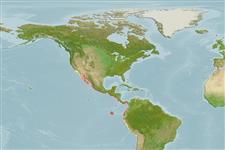>
Gobiiformes (Gobies) >
Gobiidae (Gobies) > Gobionellinae
Etymology: Ctenogobius: Greek, kteis, ktenos = comb + Latin, gobius = gudgeon (Ref. 45335).
More on author: Günther.
Environment: milieu / climate zone / depth range / distribution range
Ecologie
marien; brak water demersaal. Subtropical; 35°N - 19°S, 121°W - 70°E
Eastern Pacific: San Diego Bay, California, USA (Ref. 2850) to Peru.
Grootte / Gewicht / Leeftijd
Maturity: Lm ? range ? - ? cm
Max length : 20.0 cm TL mannelijk / geslacht onbekend; (Ref. 2850)
Facultative air-breathing (Ref. 126274); Inhabits shallow sand or mud bottoms of bays and estuaries. An intertidal species that actively shuttles back and forth between rock pools and air (Ref. 31184). For food ingestion it leaves the home pool during low tides, takes a mouth full of mud and returns to its pool where it washes out the mud through its gill membrane and swallows particles which are sieved by the gill rakers (Ref. 92840). Breathes air when out of water (Ref. 31184).
Levenscyclus en paargedrag
Maturiteit | Voortplanting | Paaien | Eieren | Fecunditeit | Larven
Allen, G.R. and D.R. Robertson, 1994. Fishes of the tropical eastern Pacific. University of Hawaii Press, Honolulu. 332 p. (Ref. 11482)
Status op de Rode Lijst van het IUCN (Ref. 130435: Version 2024-1)
Gevaar voor de mens
Harmless
Gebruik door de mens
Tools
Speciale rapporten
Download XML
Internetbronnen
Estimates based on models
Preferred temperature (Ref.
123201): 19.5 - 28.9, mean 24.5 °C (based on 268 cells).
Fylogenetische diversiteitsindex (Ref.
82804): PD
50 = 0.5000 [Uniqueness, from 0.5 = low to 2.0 = high].
Bayesian length-weight: a=0.00708 (0.00449 - 0.01117), b=2.85 (2.72 - 2.98), in cm total length, based on LWR estimates for this species & (Sub)family-body (Ref.
93245).
Trofisch niveau (Ref.
69278): 3.7 ±0.5 se; based on size and trophs of closest relatives
Weerstandsvermogen (Ref.
120179): Gemiddeld, minimale populatieverdubbelingstijd 1,4-4,4 jaar (Preliminary K or Fecundity.).
Fishing Vulnerability (Ref.
59153): Low vulnerability (10 of 100).
